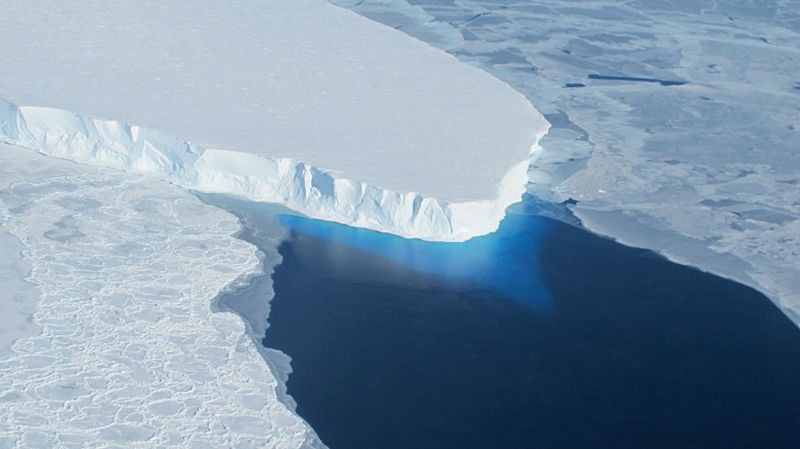Scientists have detected disconcerting and worrying indicators near the planet's southern end, notably in one of the ice shelves protecting the Antarctic's so-called "Doomsday glacier." In contrast, the planet's fast warming terrain transforms the topography of the Arctic area up north.

Doomsday Glacier
Researchers presented satellite images taken just last month at the American Geophysical Union's annual meeting on Monday, indicating that the critical ice shelf holding together the Thwaites glacier in western Antarctica - an essential defense against global sea-level rise - could shatter within the next three to five years.
Doomsday Glacier
The Thwaites glacier in Antarctica is known as the "Doomsday glacier" because of the grave danger it poses throughout its melting process. It has poured billions of tons of ice into the sea, and its extinction might have catastrophic consequences for the rest of the world.
The glacier, which is the size of Florida or the United Kingdom, contributes about 4% of annual global sea-level rise, loses about 50 billion tons of ice each year, and is becoming increasingly vulnerable to climate change. The ice shelf's disintegration might lead to the eventual collapse of Antarctica's most important glacier.
Rising Sea Levels
Researchers estimate sea levels would rise by several feet if the Thwaites fell, putting coastal populations and low-lying island nations in danger.
However, Ted Scambos, a glaciologist at the University of Colorado Boulder and a leader of the International Thwaites Glacier Collaboration, believes it will be decades before the world sees a genuine acceleration and an increase in sea-level rise.
"What's interesting about Thwaites is that the shift will be pretty severe and detectable within the next several decades," Scambos told CNN.
Related Article: Zombie Fires in Siberia Burns Under 75 Degrees Below Zero
What's Holding the Glacier?

Doomsday Glacier
A major floating ice shelf is currently holding the glacier back.
"What's most alarming about the current discoveries is that they indicate to the collapse of this ice shelf, this type of safety belt that keeps the ice on the ground," said Peter Davis, an oceanographer with the British Antarctic Survey, to an interview. "If this ice shelf is lost, the glacier will flow more swiftly into the ocean, leading to sea-level rise."
Oceanic Warming
Warming ocean waters are a major contributor to the fast degradation. According to the International Thwaites Glacier Collaboration, which is directing continuing research in the Antarctic, discovered the ocean floor is deeper than previously thought, with deep passageways allowing warm ocean water to melt the underside of the ice report published in 2020.
The findings suggest that the Thwaites' vital ice shelf is losing its grasp on the underwater mountain, or seamount, which functions as reinforcement against the ice river pouring into the warm ocean. The so-called "ice tongue" of the Thwaites Glacier has also been discovered to be little more than a "loose cluster of icebergs" that no longer impacts the stable section of the eastern ice shelf.
The so-called "grounding zone," where the ice meets the seabed, is also threatened by warm water. Davis and his crew drilled access tunnels through the ice shelf's surface and deep into the ocean cavity underneath it using hot water. They determined that the ocean waters at the grounding line are warm by arctic standards and salty, preparing the environment for additional erosion.
Grounding Zone
The physical qualities of the grounding zone, such as warm water, rough ice, and a steep, sloping bottom that permits the water to rapidly melt the ice sheet from below, reveal signals of disorder, according to Peter Washam, a Cornell University research associate. He is also engaged with the project.
"We predict the Thwaites grounding line in the region to gradually retreat up the seabed slope it now sits on in the coming years as the heated ocean eats away at its underbelly," Washam said. His team employed Icefin, an underwater vehicle that allows simpler studying ice and water around and beneath the ice shelf.
The Thwaites Glacier in Antarctica, according to Davis, is quickly degrading. Warm ocean water is gradually erasing the ice underneath it, causing water to flow faster, shattering more ice, and posing the possibility of collapse.
"We're seeing these large cracks spreading throughout the ice shelf surface, effectively weakening the fabric of the ice; kind of like a windshield crack," he added, referring to satellite data. "It's steadily expanding across the ice shelf, and it'll ultimately shatter into several pieces."
A Helpful Study
While the process is exceedingly slow and the major effects will not be realized for decades, Scambos believes it is practically difficult to halt.
"This is a geologic phenomenon," he explained, "but it's happening on a human-lifetime scale." "As a calamity for humans alive today, it is extraordinarily slow-moving; the best approach is to delay the forces driving the ice in this direction."
As the effects of the climate crisis extend worldwide, the researchers argue that boosting scientific study to understand changes in both the Arctic and Antarctic areas is crucial for developing mitigation techniques like coastal defenses in vulnerable communities.
"Aside from slowing things down," Davis added, "we can't really do much to stop this from happening." "We're basically taking the repercussions of what we've been producing for the last couple of decades, if not longer, because of the way we've been going with our carbon emissions so far."
Also Read: Experts Warn of Dramatic Sea Level Rise if Antarctic Volcanoes Erupt
For similar news, don't forget to follow Nature World News!
© 2024 NatureWorldNews.com All rights reserved. Do not reproduce without permission.

![Tsunami Hazard Zones: New US Map Shows Places at Risk of Flooding and Tsunamis Amid Rising Sea Levels [NOAA]](https://1471793142.rsc.cdn77.org/data/thumbs/full/70325/280/157/50/40/tsunami-hazard-zones-new-us-map-shows-places-at-risk-of-flooding-and-tsunamis-amid-rising-sea-levels-noaa.jpg)



